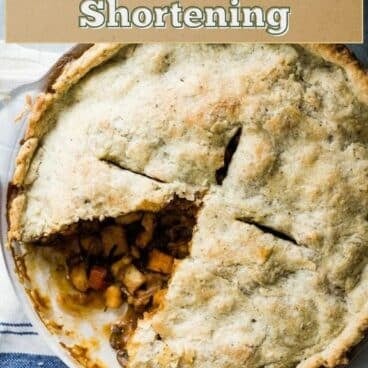This post may include affiliate links; see our disclosure policy.
There are plenty of options if you don’t want to use shortening! Here’s the best substitute for shortening in recipes and baking.

These days, shortening isn’t in good graces. What is it, and what’s a substitute if you find it in a recipe? As two cookbook authors and recipe experts, we’re here to help.
What is shortening?
Shortening is a type of fat used in cooking and baking. It’s been popular in American kitchens since the early 1900’s. It’s often used in baked goods like cookies, cakes, and pie crusts to provide a tender, flaky texture. These types of doughs are called short doughs, as opposed to long doughs that are stretchy like pizza dough.
Because of the high content of trans fats, shortening is used less often in baking these days. Many companies have reformulated their shortenings to remove trans fats, but they’re still highly processed and it’s considered better to use healthy alternatives (source). Here are some of the best alternatives for shortening in baking.
Best substitutes for shortening
1. Butter.
Butter is a natural substitute for shortening. It provides a similar texture and even more of a savory flavor. Keep in mind, butter has a lower melting point and contains water, which can make baked goods less flaky and more prone to spreading. If you’re substituting butter in a recipe that calls for shortening, here’s the ratio:
Ratio: 1 cup + 2 tablespoons of butter for 1 cup shortening.
2. Coconut oil.
Coconut oil is a great plant based substitute for shortening. It’s solid at room temperature, and you can melt it or beat it in the same way as butter or shortening. Keep in mind that coconut oil can add a subtle coconut flavor to the end product. Refined coconut oil has a more neutral taste than unrefined coconut oil, so it has less effect on the flavor.
Ratio: 1 cup coconut oil for 1 cup shortening.
3. Lard.
Lard has similar properties to shortening and a rich flavor. It’s a solid animal fat, so if you prefer vegetarian or vegan options chose the options above.
Ratio: 1 cup lard for 1 cup shortening.
Related recipes
Here are some recipes where shortening might traditionally be found that use coconut oil or butter:
- Easy Vegan Cornbread
- Best Homemade Cornbread
- Homemade Pie Crust
- Best Vegan Pot Pie
- Best Apple Pie Recipe
Frequently asked questions
Shortening is a solid fat, typically made from vegetable oils, used in baking to create tender, flaky textures in pastries, pie crusts, and cookies. It has a high melting point, which helps baked goods maintain their shape and prevents them from becoming greasy.
For pie crusts, butter is often preferred for its flavor, though shortening can provide a flakier texture.
Butter is a popular choice for cookies, as it adds a rich, buttery flavor. Coconut oil works as a plant-based dairy-free option.




Only have vegetable oil can I mske.peanut butter cookies
No, you need the thickening of the shortening.
What is the best substitute for a cup of shortening
1 cup + 2 tablespoons of butter
Wanted to substitute coconut oil for shortening. Or would oil be better. Using in peanutbutter cookies. These are frozen in a rolls. Then sliced in rounds. The typical cross forking is placed before baking. The first time only refrigerator is necessary but each roll makes 3 dozen.
Coconut oil should work!
Ratio to use butter in place of shortening
3 tbs of shortening
About 3 1/2 tablespoons.